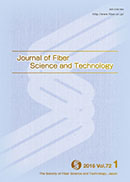
- |<
- <
- 1
- >
- >|
-
Chiaki Tanaka, Yoshinari Yui, Akira Isogai2018Volume 74Issue 3 Pages 60-66
Published: March 10, 2018
Released on J-STAGE: March 08, 2018
JOURNAL FREE ACCESSCotton fabric was oxidized with 2,2,6,6-tetramethylmpiperidine-1-oxyl radical (TEMPO) or 4- acetoamido-TEMPO (4-AcNH-TEMPO) and sodium hypochlorite (NaClO) as catalysts and sodium chlorite (NaClO2) as a primary oxidant in a phosphate buffer at pH 6.8. The reaction temperature was increased from room temperature to 80 ̊C for the initial 43 min and then maintained at 80 ̊C for ~120 min. Portions were taken from the reaction mixtures at various reaction times, and their radical concentrations owing to TEMPO or 4-AcNH-TEMPO were determined using an electron spin resonance apparatus. The concentrations of 4- AcNH-TEMPO and TEMPO during oxidation of cotton fabric with 4-AcNH-TEMPO/NaClO/NaClO2 and TEMPO/NaClO/NaClO2 systems, respectively, were determined to study oxidation mechanisms/processes. As a result, the relationships between radical concentration and reaction time during heating from room temperature to 80 ̊C and during a constant temperature at 80 ̊C were successfully obtained. The results provided fundamental information concerning oxidation mechanisms/processes of cotton fabric under the reaction conditions used in this study. Moreover, the changing patterns of carboxylate content and viscosityaverage degree of polymerization of the oxidized cotton fabrics were studied in terms of reaction times,temperatures, radical concentrations, and oxidation mechanism/processes.
View full abstractDownload PDF (2124K)
-
Lihua LV, Changwei Li, Jing Guo, Yongfang Qian, Yumei Gong, Xiang ...2018Volume 74Issue 3 Pages 67-72
Published: March 10, 2018
Released on J-STAGE: March 08, 2018
JOURNAL FREE ACCESSDiscarded polyester fiber was used as reinforced material and thermoplastic polyurethane was used as matrix material. The fiberboard composite was fabricated by blending and hot processing. Then, the fiberboard composite was drilled and coupled with discarded polyester fabric to fabricate the monolayer structural composites. Finally, the monolayer structural composites with different sound absorption coefficients were cascaded to form the three-layer structural composites. And, the sound absorption peak position of three-layer structural composites shifted to low frequency range, and the sound absorption band of three-layer structural composites was broadened. The three-layer structural composites had better sound absorption property and application prospects than the monolayer structural composites. Theoretical sound absorption coefficients were obtained by theoretical calculation and they had good agreement with the experimental results. The good agreements of comparisons proved the validity of the calculation method.
View full abstractDownload PDF (2352K)
-
Tatsuo Yamauchi2018Volume 74Issue 3 Pages 73-75
Published: March 10, 2018
Released on J-STAGE: March 08, 2018
JOURNAL FREE ACCESSLaboratory paper recycling or beating with a PFI mill alone did not affect the fiber length distribution, and their effects on the mean fiber length and fines fraction were minimal. On the other hand,beating in addition to recycling caused a decrease in the mean fiber length and an increase in the fines fraction, leading to a distinct change in the fiber length distribution, that is, an increase in the short fiber fraction and the appearance of a characteristic peak from the fines fraction.
View full abstractDownload PDF (2027K)
- |<
- <
- 1
- >
- >|